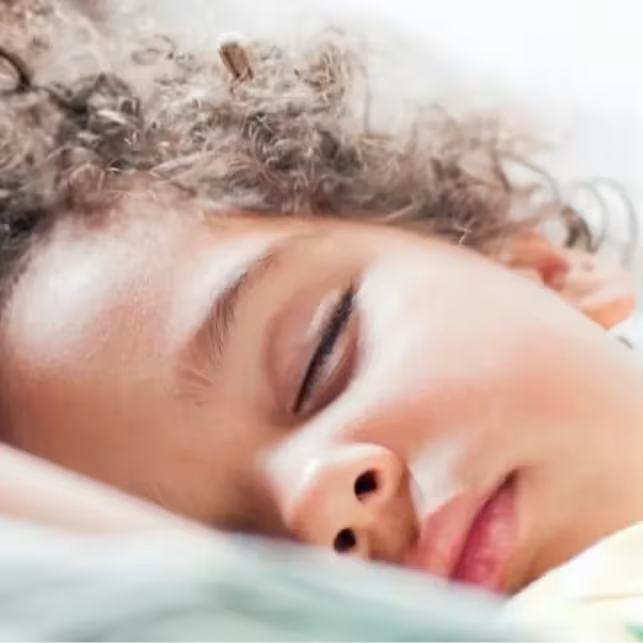Sleep training for 3-4 year olds: How to, methods and tips
Updated Dec 02, 2025

When it comes to , most people think of crying babies up all night, however, there are always going to be times in your child’s life when sleep goes awry. In fact, sleep troubles are fairly common in preschoolers. You are not alone!
Whether or not your child has never slept well, or this is a new hurdle, the good news is that it’s never too late to adjust and learn new sleep habits and behaviors. We are happy to help guide you!
Choosing the right sleep training approach for you and your child takes some consideration. Deciding whether to sleep train or not is completely up to you. If your kiddo already sleeps well, and you’re not interested in sleep training, that’s understandable too.
Before delving into specific sleep training techniques, it's crucial to understand the significance of quality sleep. Sleep is essential for your child's growth, development, and overall well-being. Adequate sleep promotes [] cognitive functioning, memory consolidation, emotional regulation, and physical health.
Table of Contents
Can you sleep train 3-4 year olds?
Yes, you can sleep train 3-4 year old children. Sleeping training older children can be quite different from sleep training infants, but it is certainly achievable. Preparation, setting boundaries, schedules, and routines are some of the ingredients needed when it comes to improving sleep.
If you are patient and consistent with your approach, you and your family will be getting the sleep you need. How awesome is that?
How many nights does it take to sleep train a 3-4 year old?
Before embarking on any official “sleep training,” preparing for the upcoming changes is super important. Have a chat with your child a few days before so they get a heads up about the changes that are coming and it isn’t a surprise. Try not to talk about it too much though as this can create some anxiety — aim to keep it simple.
You may also need to dedicate a few days to adapting to the sleep environment. This may mean purchasing or making any resources you need. For instance, you might buy a toddler clock (i.e. a clock designed to act as a visual cue for when a child should be asleep and when it’s okay to get out of bed) and craft a sticker chart for positive reinforcement. Depending on your child, this may be something you do together and make it fun!
Once you are ready to sleep train, depending on which method or combination of methods you choose, you should see a big improvement within one-to-two weeks. If you prefer slow and steady, that may take about three to four weeks. Be mindful of taking things too gradually as your child may become impatient and your progress can stall.
Sleep training methods for 3-4 year olds
| Sleep training method | Does it work for 3-4 year olds? |
|---|---|
| Gentle method, including chair method | Yes! This works best for those children who still need physical touch and/or someone in the room in order to fall asleep. Some children find it more frustrating to have someone in the room if they are not cuddling in bed anymore. |
| Ferber method or gradual extinction technique | Yes! This suits children who are comforted by regular “check-ins.” This works well for parents who have other children in the house to attend to. |
| Door shutting or door closing method | Yes! Can be a good deterrent to prevent your child from getting out of bed. This can be used as part of the chair method or Ferber/gradual extinction method. |
| Cry it out or total extinction | Yes, if used with a door gate or door monkey (which is a product that can attach to a bedroom door and be used to keep the door “locked” in an ajar position). Children this age can get out of the room very easily so this can be a harder approach to implement if your child can leave their sleep environment. If using this method, we do recommend using a video monitor or check-in every once in a while for safety. |
It can be a bit confusing where to start. If you’re undecided, start with a more gradual approach and see how your child responds. Give it a few nights and if there is no improvement at all, it is fine to switch methods. There can be a setback night or two midway through. This doesn’t mean what you are doing isn’t working, it's just part of the process when changing a habit.
Gentle method including the chair method
The aim is to make changes to sleep habits very gradually. For example, you may swap a bottle of milk and a cuddle for zero milk and just a cuddle. Next, you would sit next to your child on a chair and pat or hold their hand to sleep. Then, you gradually transition yourself out of the room (chair method) so your child is falling asleep completely independently. This process is also known as “fading.” This method suits those families who prefer to take things slow.
You may also want to move onto the Ferber or gradual extinction method next if your child still needs some “check-ins” for a few nights.
Ferber method or gradual extinction technique
The is known as a modified “cry-it-out” (CIO) or “check-in” method. After lights out, you leave the room but have the door ajar. From there you implement timed “check-ins”. You may choose to start with 2 min, 3 min, 4 min, 5 min, etc. check-in intervals that gradually increase over time until your child has fallen asleep. You only reenter the room at your designated time. You can offer occasional physical touch during “check-ins” with the intention of phasing that out. Next night you might start at 3 mins, 4 mins, etc.
An alternative to the increase of intervals as just explained is to offer timed check-ins but have a limit on the amount of checks you do each night. For example, on the first night, you may decide to do 5 visits. Say “Again I will check back in 1 minute.” Next, you will say “Again I will check back in 3 minutes”, then “Again I will check back in 5 minutes, then “Last check I will be back in 7 minutes.” On the final check, you say, “All done with checking-in. See you in the morning, love you!” The next night you might start at 2 mins etc and only offer 4 check-ins. You can adapt it to suit your family.
This isn’t a good fit for all families. Some children get disturbed or upset with someone coming in and out of the room. If this is the case for your child, they may leave the room looking for you.
This method best suits children who are more distracted with you in the room. If your child is in a bed, we do recommend using a safety gate or door monkey to keep your child safely in their room. This method can be used in conjunction with the “door closing” method.
Using a toddler clock and reward chart can be a good incentive to stay in their bed. More details on this, are below.
The door shutting or closing technique
This method can be used on its own or in conjunction with other methods. This implements a tougher consequence if your or their room.
After lights out, you leave the room but keep the door ajar. If your child gets out of bed they get a warning that if it happens again the door will be closed/shut for 1 minute. If your child gets up again, you hold the door closed for that designated time. Once the timer is up, open the door, lead your child back to bed, then leave with the door ajar. If your child gets out again, you close the door for 2 minutes. Keep repeating and increasing the closed-door intervals. The following night, after an initial warning, you may start at 2 minutes, and so on.
As with most methods, using a toddler clock and reward chart can be a good incentive to stay in their bed.
Cry it out (CIO) or total extinction method
With a , after lights out you don’t return to offer any form of reassurance at all until morning. You will need to use a safety gate or door monkey to prevent your child from leaving their room.
We do strongly recommend using a video monitor or quietly checking from the doorway a few times for safety reasons.
Again, using a toddler clock and reward chart can be a good incentive to stay in their bed.
Sleep training tips for 3 - 4 year olds
| Sleep training tip | Why it helps | What to try |
|---|---|---|
| Set boundaries but offer choices | Predictability helps preschoolers feel secure and cooperative at bedtime. | Keep structure while giving limited choices — like picking between two books or pajamas — to promote independence without overwhelm. |
| Use a sleep clock and rewards | Visual cues and small incentives motivate kids to stay in bed and follow routines. | Try a sleep clock with color signals for “sleep” and “wake.” Offer stickers or small prizes for staying in bed all night. |
| Keep an eye on timing | Overtired or under-tired kids struggle to settle — timing impacts everything. | Follow an age-appropriate schedule and adjust bedtime to avoid second-wind energy or bedtime battles. |
| Address fears or separation anxiety | Many preschoolers experience nighttime worries that can disrupt sleep. | Listen and reassure. Use nightlights, comfort objects, or calm music to help your child feel safe. |
| Expect some setbacks | Sleep progress isn’t linear — regressions are part of learning. | Stay consistent after travel, illness, or disruptions. Re-establish routines and encourage independent sleep skills. |
Find more details below:
Tip #1: Set boundaries but offer choices
Children thrive on and predictability. Clear rules can be especially helpful for little ones. An example is to offer limited choices in the bedtime routine such as “Which one of these two books do you want me to read tonight?” or “Which pajamas out of these two do you want to wear to bed?” Don’t offer 10 books or 3 pajamas as that becomes overwhelming and can delay bedtime.
Tip #2: Use a sleep clock and incentives/rewards
A sleep clock is a great way to indicate to your child when nighttime ends and when daytime begins. Sleep clocks use colors to cue your kiddo that it's time for sleep or when it's morning to wake up. You can set a bedtime setting and a wake-up time! If they have remained in their bed all night, they can earn a small reward or treat.
Tip #3: Timing is everything
Mis-timings at bedtime can cause meltdowns and tantrums for some, or hyperactivity in others. can be a common occurrence for this age too. Total FOMO! Following an age-appropriate can be really beneficial. Both under and over-tired children will struggle to fall asleep and stay asleep, so timing is crucial.
Tip #4: Address any fears or separation anxiety
At the age of 3 - 4, children may experience fears or , which can disrupt their sleep. Take the time to listen to your child's concerns and provide reassurance. Offer a nightlight or a special toy to help them feel secure. Implement relaxation techniques, like deep breathing or gentle music, to help calm their anxieties before bedtime.
Tip #5: Expect some setbacks
When establishing a new habit, it can take time and the road can be a little bumpy. Once your child is sleeping better, there will be times when they are more wakeful during the night or resistant to going to bed. This could be due to illness, travel, mis-timings, learning a new skill, or maybe for no obvious reason at all. If you can approach each sleep session “fresh” by continuing to encourage those independent sleep skills whenever possible, that setback should be temporary.
Can you sleep train 3-4 year olds for naps?
Maybe. Sleep training for naps is typically harder than for nighttime sleep. We find that children this age may strongly resist the new way of falling asleep at naptime or skip the nap entirely. It is worth giving it a go for at least a week using the same method you are using at nighttime, and you may find your child is receptive to the change in sleep habits. Happy days!
If your child still needs a nap, but you are not making progress, consider helping them to sleep just for naps in order to make sure they are getting sufficient sleep.
What to do if sleep training my 3-4 year old is not working?
We know sleep training isn’t always easy. Success can be a bit up and down. What you are aiming for is progress, not perfection.
Here are a few things to consider if sleep training is not working for you.
Children like to test rules and boundaries, so suddenly hopping out of bed on night 7, when they have been doing so well previously, is totally normal. Your child wants to test what will happen if they do and if you will be true to your word by remaining consistent. Setbacks are common.
Ensure your child is falling asleep completely independently. If you keep coming back for one more hug or one more tuck-in, they will expect this when they wake in the night or keep asking for more when falling asleep initially.
Switch methods or go a little faster. Sleep training isn’t about mastering each step before moving on.
Check how long it is taking your child to fall asleep and adjust the timings accordingly. Your child may be ready to which can delay bedtime or cause night wakes. Both over and under-tired children will stall at bedtime or wake in the night. Make sure you follow an .
Could there be any underlying medical reasons causing sleep difficulties? If your child is really struggling to fall asleep or continues to wake in the night, we recommend consulting with your pediatrician. Sweating, congestion, recurring ear infections or snoring can be indicative of ENT issues. Some drugs such as asthma medication can contribute to insomnia.
Reach out to us for a customized sleep plan through .
Takeaway: Sleep training 3-4 year olds
Sleep training 3 - 4 year olds requires patience, consistency, and understanding: Remember that every child is unique, and it's essential to adjust the techniques to suit your child's individual needs. With consistency and perseverance, you can support your child in achieving quality sleep.
Don’t forget to celebrate the small wins: Try not to feel disheartened if your child needs a bit more time to master those independent sleep skills. Keep going and remember — you’ve got this!
If you're looking for more resources, take a glimpse at information on .
Sleep training for 3-4 year olds FAQ
Share article:
Note: The content on this site is for informational purposes only and should not replace medical advice from your doctor, pediatrician, or medical professional. If you have questions or concerns, you should contact a medical professional.
2 Sources
Table of Contents
Share article:










